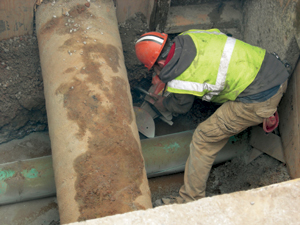Pipe Bursting Rehabs Aging Ohio Sewer Lines
January 1, 2009
 Pipe bursting and auger boring were used to rehab an older residential section of the City of Avon Lake, Ohio, upgrading approximately 6,000 ft of deteriorated vitrified clay sewer pipes with HDPE along two streets.
Pipe bursting and auger boring were used to rehab an older residential section of the City of Avon Lake, Ohio, upgrading approximately 6,000 ft of deteriorated vitrified clay sewer pipes with HDPE along two streets. The city has experienced sanitary sewer backups during heavy rain events for the last few years. Avon Lake, with a population of approximately 18,000, is located on Lake Erie, just west of Cleveland.
Avon Lake Municipal Utilities (ALMU) officials were able to trace the problem to inflow-and-infiltration of storm water and groundwater into the sewer line, which were originally installed in 1929. The problem area was in the northeast quadrant of the city, along Fay Avenue and Vineyard Road.
ALMU is no novice when it comes to utilizing trenchless technology to resolve underground infrastructure problems, having used it a few times in the recent past. Two factors helped to sway the use of trenchless in this particular case: cost and non-disruption of the regular neighborhood traffic.
“We did a pipe bursting project in 2006 and our bid price was half the cost compared to open-cut,” explains ALMU engineering services manager Jack Gaydar, P.S., P.E. “That’s why we are a proponent of trenchless technology. It’s a major cost factor in infrastructure rehabilitation. We need to be very cost-conscious with our ratepayers’ money and ensure that we get a quality product that is going to last for 100 years. Trenchless technology allows us to do that.”
Total cost for the trenchless and open-cut work on the project was $1.473 million.
Condition Assessment
ALMU started the process by using CCTV to inspect the suspect sewer lines and laterals, giving officials a condition assessment of what they were dealing with. Great Lakes Pipeline Services, Cleveland, Ohio, handled both of these jobs in late 2007 and early 2008, using a CUES LAMP inspection system. What ALMU saw in the footage was seriously deteriorated pipe in a number of sections.
“We started out by doing sewer flow monitoring of the mainlines during dry weather events and comparing the results to those done during wet weather events,” explains Gaydar. “That camera inspection of the mainline found that we had cracked pipe, broken pipe, misaligned joints, mortar joints that had degraded due to hydrogen sulfide and water entering the pipes from the pavement. Underneath the manhole frame castings, there was leaking at the brick joints.”
ALMU also noted some areas of concern with the laterals in that first inspection, namely improperly sealed laterals and missing gaskets, joints and cement, which allowed debris or water to enter. Seeing this, ALMU had Great Lakes Pipeline conduct a lateral assessment. “When we did the mainline inspection, there was a noticeable increase in clear water in the laterals. That’s what prompted us to go back in and do a lateral assessment,” Gaydar says.
This assessment gave more details of the laterals’ condition, which included signs of water infiltration through leaky joints and broken pipe. CCTV also showed root infiltration, as well as grease blockage.
“In Avon Lake, as in most places, the property owners are responsible for their own sanitary laterals from the home to the mainline,” Gaydar says. “But we felt that in order to properly complete this project that we also had to repair the laterals as they were contributing a high amount of I/I.”
On with the Project
Based on its past success with pipe bursting, ALMU decided to go with this method for this particular project, replacing the vitrified clay pipe with HDPE. A small section of 10-in. PVC installed a few years ago would also be pipe bursted using the HDPE, as ALMU wanted to upsize the pipe diameter to 12 in. Auger boring would be used to cross 70 ft under a state highway, which carries a high volume of traffic.
The diameter of the original vitrified clay pipe was 10, 12, 15 and 18 in.; ALMU upgraded the lines using 10-, 12- and 14-in. HDPE. Gaydar says ALMU chose HDPE for the project because “it would provide a smoother area for the flow, as compared to the joints in a vitrified clay system.”
ALMU contracted with Utilicon Corp., Cleveland, to handle the pipe bursting work, as well as manhole replacement and lateral repair. Utilicon has experience with trenchless methods such as sliplining, lining and pipe jacking, but this project marked the first time it has utilized pipe bursting. Utilicon’s Bill LoPresti, P.E., explains that the company teamed with TT Technologies on the project. The manufacturer provided the equipment, as well as training and onsite assistance.
“Utilicon did an excellent job. There were no problems,” Gaydar says.
ALMU considered pipe bursting the laterals as well but decided to go with the open-cut route. “We had designed the lateral portion of the project for open-cut. The contractor proposed using lateral pipe bursting, based on its consultation with TT Technologies,” says Gaydar. “But after careful consideration and review of the existing laterals in relation to a storm sewer and very old water main, we decided that the risks were too high to use pipe bursting.”
Work on the project — called The Fay Avenue and Vineyard Road Sanitary Sewer Replacement Project — started in September and was completed by the end of November.
Sharon M. Bueno is managing editor of Trenchless Technology.
